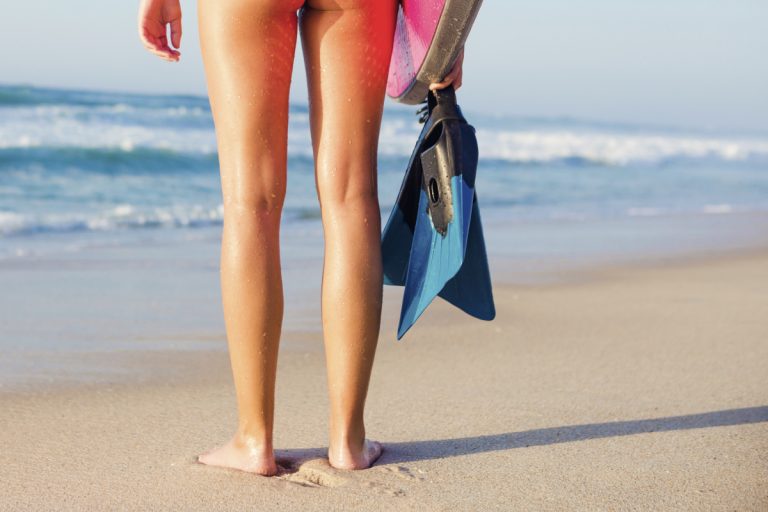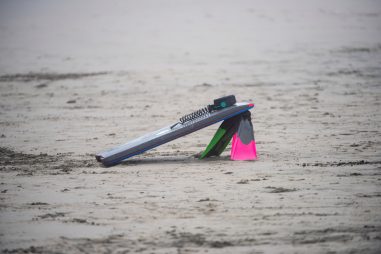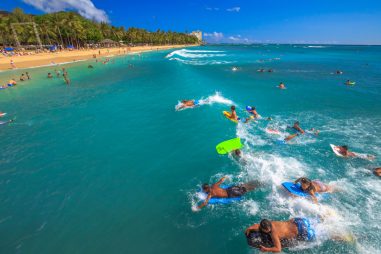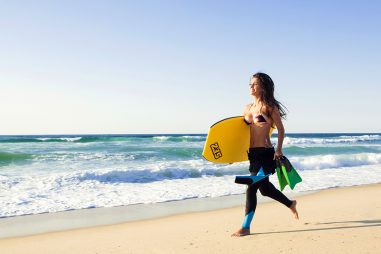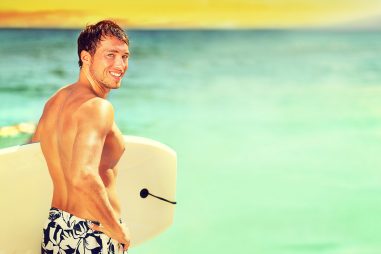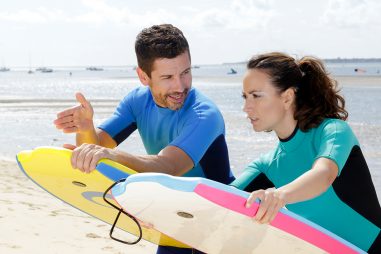Bodyboarding continues to dazzle people all over the world because of how easily you can start the sport. Aside from that, you also don’t need much to be able to start and excel in the sport. Oftentimes, you just need to find the perfect bodyboard and fins for you to get started. If you want to know how to choose the perfect bodyboarding fins for you, then read on!
What Are Bodyboard Fins for?
Fins are essential if you want to excel in bodyboarding. While you can ride your bodyboard just fine without fins, wearing them makes a lot of difference. For one, they act as a propulsion device that helps you accelerate your speed in order for you to catch more and better waves. Fins allow you to add power to your paddles in order for you to be quick enough to ride more waves.
Aside from that, fins help in controlling your board while you are trimming, which is riding the surf line in a wave. Fins can also save your life, especially if you are caught in a rip current.
If you are a beginner or young bodyboarder, it’s not absolutely necessary to get fins as you would be dealing with much smaller waves that break a lot closer to the seafloor. But if you want to get serious with the sport, it is advisable to get the fins that are perfect for you.
Do Fins Help Bodyboarders?
Fins are a great help to bodyboarders, especially pro-level or advanced bodyboarders. Bodyboarders of this level take on medium to large waves that may be harder to catch. This is where fins come in because they help propel a bodyboarder forward while accelerating its speed.
Beginner bodyboarders may hold off on learning how to bodyboard while wearing their fins. This is because beginners often practice in the shallow and sandy part of the sea, and this part often produces smaller waves that you can catch without the help of fins.
Why Do Bodyboarders Use Fins?
Using fins while bodyboarding has proved beneficial for bodyboarders time and time again. While it is okay for beginners to skip wearing fins while practicing in shallow waters, advanced bodyboarders benefit a lot from wearing them. Here are some of the benefits that wearing fins provide to bodyboarders:
- Helps in acceleration: Medium to large waves are harder to catch, much less ride because they move faster than, say, shallow and smaller waves. Because of this, you would need to paddle faster in order to catch them. This is where fins come in. They act as a type of propulsion device that adds power to your paddles. Fins help add acceleration for you to be able to catch more waves.
- Helps control the board: As you progress into the sport, you will learn how to trim across the waves. Trimming is said to be the art of riding the surf line of a wave. When you perfect the skill of trimming, you will be able to surf more parts of the wave. You would also be able to execute tricks better and easier. When trimming, it’s normal that you generate more speed. Fins will help you in controlling your board as you go fast while trimming.
- Added safety: The water and weather conditions can be both unpredictable, and this adds to the risks in watersports. Fins can help save your life if you get in trouble in the water. It can help you if you get caught in a rip current or if you are dragged out into the open sea. You would also be able to swim faster if you happen to get caught in a freak wave.
- More fun: Bodyboarding is infinitely more fun if you can catch more waves or even bigger waves. And since fins can help you catch more waves, the fun factor does go up. It also helps you progress in the sport, practice, and go from beginner to intermediate or advanced rider.
Do You Need Fins for Bodyboarding?
While it is not mandatory to own or use fins when bodyboarding, using them does have many advantages, especially for advanced and professional bodyboarders. Bodyboarding without fins is comparable to swimming or surfing without your arms. Using fins can not only help you increase the number of waves that you catch, but it can also help you progress greatly in the sport.
If you are a beginner, you can choose to skip the fins until such time that you are ready to go further out into the ocean to catch bigger waves. But if you are serious about the sport, it would be beneficial for you to learn how to properly use fins even when you are just starting out.
Can You Use Any Fins for Bodyboarding?
If you want to be a serious bodyboarder, it is advisable to only use and practice with fins that are specially made for bodyboarding. This is because different fins are designed and manufactured for different purposes and water activities. Using a different type of fin while bodyboarding may give you different results.
If you use other kinds of fins for bodyboarding, they might hinder your progress. They would also make bodyboarding less enjoyable for you, especially if you are just starting out.
Can You Use Swimming Fins for Bodyboarding?
It is not recommended to use swimming fins if you aim to be a serious bodyboarder. This is because swimming fins are actually a different type of fin. This means that they work differently than, say, fins that are specially made for bodyboarding, and they will not help you excel in the sport.
Aside from that, swimming fins are not designed to help you in your propulsion. You would need to work twice as hard to be able to catch and ride waves when you choose to wear swimming fins.
Can You Use Snorkeling Fins for Bodyboarding?
Like swimming fins, snorkeling fins are also not suited for bodyboarding. Snorkeling fins are not designed to work the same as fins made for bodyboarding. They will not help you accelerate, and they will probably not help you in executing tricks on your bodyboard.
Snorkeling fins may also not be as durable as fins for bodyboarding. They may succumb easily to wear and tear.
Can You Use Diving Fins for Bodyboarding?
No, wearing diving fins for bodyboarding is neither advisable nor a good idea. Fins made for bodyboarding are designed to propel you near the water’s surface, while diving fins (like those used in scuba diving) are designed for deep water propulsion.
Aside from that, bodyboarding fins should support rapid movements and quick bursts of speed. Meanwhile, scuba diving fins are designed to support consistent, slow, long, and drawn-out strokes of the feet as you go or stay under the surface of the water. This is why scuba diving fins are designed to have longer fins while bodyboarding fins are way shorter, wider, and stubbier.
Can You Use Training Fins for Bodyboarding?
It is also not advisable to use training fins for bodyboarding. Bodyboarding fins offers extra propulsion when doing rapid movements, and since you don’t need extra propulsion when swimming in the pool, training fins do not have the ability to accelerate your movements.
Bodyboarding fins also need to have drainage holes to expel stones or sand as you paddle. But since training fins are often used in indoor pools or backyard pools, most of them do not have these holes since there would be nothing to expel.
Can You Use Normal Fins for Bodyboarding?
Using normal fins or general-purpose fins will also not give you the support that fins made for bodyboarding would. Most normal fins are designed to be narrower, and they have longer and more flat blades. Most of them also do not have drainage holes at the bottom of the fin foot pocket.
When you are bodyboarding, you would need a fin that would help propel you near the water’s surface. A drainage hole is also important because it will get rid of the sand, shale, stones, and other debris that have gotten inside your fins.
What Is the Best Type of Fins for Bodyboarding?
Bodyboarding fins are the best choice for bodyboarding. These fins are designed to be wider, shorter, and stubbier. This is because these fins are meant to offer extra propulsion as you make rapid strokes with your feet to be able to catch a wave.
Some features of bodyboarding fins include sidebars and rivets that are parallel to the fins. They should also have drainage holes located at the bottom of the fin foot pockets, which help expel debris such as sand, rocks, and shale from the fins.
What Are the Best Fins for Bodyboarding?
There are a lot of brands selling bodyboard fins in the market today, and it can be really overwhelming if you don’t know where to start or what to look for. They carry varying sizes, and some only manufacture for specific riding styles. In buying your first fin, you should consider several things such as rigidity, comfort, fit, size, and shape.
In no particular order, here are some of the best brands that manufacture bodyboarding fins for all types of bodyboarders:
- DaFins
- HYDRO
- Cressi
- Churchill Fins
- Kpaloa Fins
- Viper
- Hubboards
- Voit
- MS Viper
- DMC Fins
If you are still unsure of what pair of fins to get, you can always visit bodyboarding shops or sports goods stores near you. They have experts that can walk you through and help you in choosing the best fins for you.
Are DMC Fins Good for Bodyboarding?
DMC Fins are known for being some of the best bodyboarding fins in the market. They are known as one of the largest manufacturers of fins, including bodyboarding fins that are top-notch. The bodyboarding fins being manufactured by DMC are great for bodyboarders of all ages and skill levels.
Some of DMC Fins’ best models include the following:
- REPELLOR: The REPELLOR is made with DMC Fins’ newest design which has a patent pending. It uses the innovative RVR or Reverse VEE Rail Technology. It is described to be ultra-comfortable, and it offers acceleration if that’s what you are looking for in a bodyboarding fin. The REPELLOR is said to act as the extension of your body, and as you kick with this pair of fins, you will sure to increase your lower body fitness, along with ankle flexibility and leg strength. The REPELLOR comes in many different sizes for both men and women.
- ELITE: This specific DMC Fins model is the chosen pair of the members of the Australian Swimming Team. This fin is made with silicon material which ensures maximum comfort. It is also designed to have a toe-drain-release which ensures that it will stay on your foot no matter how hard you kick.
- ELITE I: The ELITE I was designed to be an all-around training pair of fins, and they are very, very popular as bodyboarding fins. This is because they offer maximum comfort, among other notable features. They are also designed with DMC Fin’s patented RVR or Reverse VEE Rail Technology. DMC used soft silform in the construction of ELITE I, and they are designed to stay on your feet no matter how hard you kick.
- ELITE MAX: The ELITE MAX model was designed with the RVR or Reverse VEE Rail Technology which DMC Fins had patented. The more you wear and the more you get used to this pair, you would surely improve your leg strength and kick action. The ELITE MAX comes in many different sizes that range from 2XS up to XL.
Are DaFin Fins Good for Bodyboarding?
Like DMC Fins, DaFin Fins are also some of the best bodyboarding fins out in the market. DaFin boasts fins that are both comfortable and powerful, the features that you would need when looking for bodyboarding fins. This brand prides itself in being the first choice of lifeguards and safety professionals not only in the United States but in many countries in the world.
Some of DaFin’s bestselling bodyboarding fins include the following:
- Bodyboard Swimfins Kicks Aka Lyman: Hawaiian bodyboarding superstar Aka Lyman helped design this DaFin model. Since Lyman is from Hawaii, this fin is designed specifically for Hawaii’s big waves. But that’s not to say that you can’t use it anywhere else. It has a very comfortable foot pocket. It is also great for the drop knee position. This pair is symmetrical, and it is made with 100% natural rubber.
- Mark Cunningham Signature Swim Fin: Also called the M.C. Amber, this signature fin line is designed by bodysurfing legend and veteran lifeguard Mark Cunningham. These pairs are endorsed by several lifeguard associations in the world, including the Hawaiian Lifeguard Association and the United States Lifesaving Association. These fins are creatively designed with no color additives, which makes the foot pockets translucent, hence, the Amber in its name. It is also said to be 10% softer compared to the foot pockets of other DaFins models.
- Brian Keaulana Pro Signature: Brian Keaulana, which is a professional surfer and ocean safety specialist, helped design this DaFins model. These fins are painted with limu which translates to seaweed in Hawaiian. These particular pair of bodyboarding fins are endorsed by several lifeguard associations, including the Hawaiian Lifeguard Association and the United States Lifesaving Association. They are very lightweight, they float in saltwater, and you can wear them on either foot.
- Zak Noyle Pro Signature: In collaboration with DaFins, popular extreme surf photographer Zak Noyle released this line of bodyboarding fins. And it is for a good cause because the proceeds from this line will be donated to the North Shore Lifeguard Association. This model is also very popular for many reasons. For one, it offers both comfort and power. These fins are made with natural rubber. They are impressively lightweight, and they can be worn on either foot.
- Ha’a Keaulana Signature Kicks: In this collaboration, DaFins teamed up with Hawaiian photographer Ha’a Keaulana. They made sure that they incorporated the vibrant colors in her images to this line of bodyboarding fins. These fins are made with high-quality natural rubber. They are also very light, and they can float in saltwater. These are symmetrical fins that can be worn on either foot.
What Size Bodyboard Fins Should I Get?
The easiest trick into getting the best fins for you is to know your daily shoe size. In general, the fins that will perfectly fit you should also be the same size as your everyday shoe size. It is important to get fins that will perfectly fit you to be able to have the best experience underwater.
If possible, you should also try on the fins while you are in the store because different brands have different ways of measurements. There are also other brands that offer customized fitting on their fins. You should also consider the size when you are wearing fin socks.
How Should Bodyboard Fins Fit?
When trying on a fin, you should pay attention to its fin on your toes, the back of the foot, and the top of your foot. Overall, your fins should have a snug fit in all three areas.
For your toes, they should be close to the pocket but make sure that they are not touching the pocket because your toes should not be rubbing up against it. The back of your foot should have a snug fit on the back end of the fin but make sure that the fit is not too tight.
Lastly, for the top of your foot, you should have enough space that you can easily and comfortably do up and down movements. The top of the fin should not be too tight that it presses hard on the top of your foot.
How Tight Should Bodyboarding Fins Be?
Bodyboarding fins should have a snug fit on the toes, back of the foot, and top of the foot. Make sure that they are not too tight; otherwise, you would have a hard time moving your feet on the water.
If you buy fins that turn out to be too tight for you, it would most probably hurt your feet, and you will not be comfortable enough to stay in the water for longer.
What Are the Most Comfortable Bodyboard Fins?
Finding comfortable bodyboard fins is essential in having a wonderful time in the water. If you have no idea what to get or if you want to get an upgrade to replace your less comfortable pair, here is a short list of some of the most comfortable fins in the market today:
- Kpaloa Swim Fins Pro Model: Brazilian fin manufacturing company Kpaloa is known for designing fins that offer maximum comfort. Kpaloa Pro model is particularly popular for its superior comfort. This is because the foot pocket of this pair is made with ultra-soft rubber, which means you won’t experience cuts or chafing on your feet when you bodyboard with this pair. The Kpaloa Pro comes in many different sizes that will surely fit both men and women of all ages and skill levels.
- Hydro Tech 2: This award-winning pair of bodyboard fins is popular because its foot pockets offer superior comfort for all foot types. It is specifically designed to avoid fin catching for bodyboarders who like to do the drop knee position. It also has a contour ankle strap that also boosts comfort. The design of this pair of fins ensures that you will be experiencing less strain and injury because it lessens the leg twist motion.
- Churchill Makapuu Pro Bodyboard Swim Fins: The Makapuu model of the Churchill Fin company is a particularly famous pair not only because it has been in the market since 1936 but also because it offers superior comfort. It has a slip-on design that allows the bodyboarder to wear the fins comfortably. This model also comes in a variety of sizes to ensure that it will fit men, women, and the youth. The foot pocket itself is made with soft material that will ensure maximum comfort.
Best Bodyboarding Fins for Wide Feet
You should highly consider the shape of your feet when buying your fins. While some have slimmer or narrower foot sizes, there are also a lot of bodyboarders with wide feet. If you are on the lookout for fins that would be comfortable for a wide fit, then check out these pairs below:
- HYDRO Tech 2: This specific pair of bodyboarding fins was proclaimed the winner of the Australian Design Award. It was designed to be perfectly comfortable, especially for bodyboarders with wide feet. The contour ankle strap offers perfect fit and comfort. The HYDRO Tech 2 was designed to equally distribute the force around the foot, and it follows the natural movement of your body.
- MS Viper: This is the go-to pair of Mike Stewart (yes, the bodyboarding legend!). Stewart has wide feet, and he stated that the foot pocket of the MS Viper fits him very well. Aside from the comfort that it gives, the MS Viper is also a good planing surface. If a legend chooses this pair for his feet, there’s no reason to pass up on this one!
- Churchill Fins: Both the Makapuu and the Makapuu Pro, two of Churchill Fins’ best and most popular fin models, are great for bodyboarders with wide feet. They are incredibly comfortable because their foot pockets will fit most foot types.
- Cressi Palau Swim Fins: Cressi Palau has been around since the 1930s, so you are to find a bodyboard fin that will best suit your foot type. Cressi Palau is known for having varying sizes on their fins which means that even if you have wider feet, you will surely find one that will fit you.
Best Fin Socks for Bodyboarding
There are a lot of fin socks in the market. They come in different thicknesses and are made with different materials. There are also a lot of brands coming up with new designs, which makes choosing the perfect fair really overwhelming. To help you out, here are some of the most recommended fin socks:
- AKONA 2mm Low Top Neoprene Dive Sock: This 2 mm fin sock is made with neoprene which offers more insulation, especially if you choose to bodyboard in cooler waters. They are perfectly reliable and durable because they have seams that minimize the water flow. It is also designed with airprene side panels to ensure that the water will drain while still providing protection and warmth on your feet.
- Pride Neoprene Fin Socks: Made by Pride Bodyboards, these fin socks claim that they are so comfortable that you won’t feel that you are even wearing fins. They come in different sizes and styles, so you can be sure to find one that will be perfect for you.
- Dakine Fin Socks: Made with 3 mm neoprene, the Dakine Fin Socks has the right thickness and amount of material between your feet and the fins. They are designed to fine-tune the fit of your fins. With its thickness, this fin sock offers added padding and protection from fin rubs, cuts, and chafing.
- Sporti Nylon Swim Sock: Made with Nylon Spandex which is considered by many as the best fabric for sportswear, this Sporti Nylon Swim Sock is another great option if you are looking for fin socks for bodyboarding. It is soft and durable and is made with a padded sole to ensure extra comfort. It is designed to have a reinforced toe and heel for protection and durability. It also has extra cuff length for added protection around the ankle.
Why Are Bodyboard Fins Short?
Compared to other kinds of fins, bodyboarding fins are evidently shorter. This is because it is meant to support rapid movements and quick bursts of speed. The length of bodyboard fins is specially designed to be able to propel at the surface of the water.
If the fins that you will be using for bodyboarding are not short, it will take a lot more energy for you to paddle out through the surf quicker.
Why Are Bodyboard Fins Angled?
Angled bodyboard fins are designed as such so that they can support your acceleration and help you strengthen your thrusts. These kinds of fins belong to the asymmetrical bodyboard fin design category. This design is easy to spot because it is inspired by the dolphin shape, and the blades are distinctly diagonal.
This fin may offer more power and acceleration, but it may be slightly harder on your legs and feet compared to the other type of fin, which is the symmetrical design. Aside from that, compared to the symmetrical ones, asymmetrical fins have a designated left and right fin.
Churchill is known to be one of the most popular manufacturers of asymmetrical bodyboard fins. They have been designing these fins since 1936.
Do Bodyboarding Fins Stretch?
When you first buy and use your bodyboard fins, they would be snug on your feet. But as you use them longer, they would inevitably stretch and loosen due to wear and tear. While it might feel like it fits perfectly on your feet while on dry land, the fit of your fins would be different once you hit the water.
If your fins have straps at the back that you can adjust so that it fits you better, then you can easily address this problem. However, some fins are not designed with straps at the back of the fin.
Do Bodyboard Fins Float?
While some bodyboard fins are still not buoyant enough, most mid to high-end bodyboard fins out in the market today are designed to float. Buoyancy or the fin’s ability to float should also be another important consideration before you purchase a pair.
This is because if in case you lose a fin while bodyboarding, it would be easy to spot it on the surface of the water. If you happen to lose a fin that does not float, you would be forced to purchase a new pair before you can continue bodyboarding.
How Do You Wear Bodyboard Fins?
Now that you know how to choose the best pair of bodyboard fins for your skill level, size, and riding style, the next thing to know is how to properly put them on. First off, you should identify if your pair is symmetrical or asymmetrical.
It’s easy to spot asymmetrical fins because they have a designated left and right fin. It does get trickier when it comes to symmetrical fins since there is no clear indication of which way left or right goes. The best way to know which fin is going to go on which foot is to check the placement of the furthest fin blade. Remember that they must be on the outside of each bodyboard fin.
You should make sure that your foot slides all the way to the front-end of the fin. You should also pull the heel strap around the back of your ankles. Make sure that you are 100% comfortable with the fit of your fins.
Which Way Round Do Bodyboard Fins Go?
It can be tricky to know which way does the top and bottom go when you look at your bodyboard fins. The easiest way to know which one’s which is to look for the drain holes—they should go on the bottom.
If you have a pair of asymmetrical fins, you should check the furthest fin blade. You’ll know that you have put on your fins correctly when the furthest fin blade is on the outside of each fin.
How Do I Stop Bodyboard Fins Rubbing?
Even if you think you have the most comfortable pair of fins in the world, the likelihood of having fin rubs, cuts, chafing, and blisters are very high because the fins will be in constant friction with your feet. Here are some things that you can do to prevent your fins from rubbing:
- Wear fin socks: Fin socks are great because they give you added padding and comfort because the fins wouldn’t be in direct contact with your foot. There are numerous kinds of fin socks in the market. They vary in materials, thickness, and design. Most professional bodyboarders recommend neoprene fin socks which are usually 2.5 to 3 millimeters depending on the temperature of the water.
- Use medical tapes: While not as effective as wearing fin socks, some bodyboarders choose to use medical tape because it also helps to stop your fins from rubbing with your feet. Some even use medical tapes in conjunction with fin socks. It is recommended to put on the medical tape when your feet are still dry so that it will surely stick to your feet. You should remember, though, that medical tapes are only good to prevent blisters for short kick sets because they might not stay on for very long.
- Buy a new pair of fins: It is not economical but if you tried wearing fins socks or medical tape or fins socks with medical tape and you still end up getting fin rubs, then it might be the best time to try another pair of fins. The more you use your fins, the more they succumb to wear and tear. This is why your fins may not be as comfortable as when you first bought them.
How Do You Cut Bodyboard Fins?
You are allowed to modify your bodyboard fins to make sure that they will serve you best. Some bodyboarders often cut the fins to their desired length. People choose to use a different set of tools for this, such as a box cutter and jigsaw.
It is advisable to cut little by little to ensure that the fins can still give you enough thrust. Test out the fins after every cut to make sure that it still serves their purpose.
How Do You Use Fins When Bodyboarding?
It is true that wearing fins while walking and entering the water is quite difficult, especially if you are a beginner. But these are just some of the things that you should get used to if you want to excel in bodyboarding. Fins are essential in this sport because it helps you in paddling, duck diving, and catching and riding waves.
- Paddling out: It is recommended to be at least waist deep before you start paddling. In some instances, like when the surf is quiet, and the waves are relatively flat, you can choose to just paddle with your arms. However, if you need to arrive at a certain point in the water quickly, you can paddle with your arms and feet simultaneously. Use your leg power to kick your fins so that you glide fast across the water.
- Duck diving: While most bodyboarders don’t actually use their bodyboarding fins to duck dive, it is good to learn this technique because you can use it when you swim under the whitewater rumble. To get the highest level of propulsion while doing a duck dive, you must kick your fins well underwater. The harder you kick, the faster you will be propelled forward, and that means you can also come back up to the surface quicker.
- Catching the wave: In this step, it is important that you know how to choose a wave that you can ride. Use the 0-60 technique when kicking your legs. In doing this technique, you have to paddle from a still position to full speed in the quickest time possible. You must use your leg power to kick as hard as you can while keeping your feet submerged beneath the water’s surface. If you kick hard enough, you will be able to catch and ride the wave.
How Do You Kick a Bodyboard Fin?
It is not enough that you know how to use your bodyboard fin, you should be able to kick it correctly so that you would get the maximum propulsion. Remember to always kick while your feet are below the water. This will give you maximum propulsion or thrust.
Make sure that you also engage the muscles in your hips, thighs, buttock, torso, and knees. You would get tired easily if you only use your knees and feet, but if you engage these muscles, it will result in stronger kicks that won’t tire you out quicker.
Can You Bodyboard Without Fins?
Technically, you can bodyboard without fins but doing so is synonymous with surfing without arms. Bodyboarding without fins basically means that you would only be relying on the strength of your bare legs. In that case, you might not be able to move as fast, or you might not be able to propel yourself quickly.
You can choose to bodyboard without the help of fins, but you would need to adjust a few things to be able to enjoy the sport better.
How to Bodyboard Without Fins
Bodyboarding without fins basically has more rules than doing the sport with fins. You would have to adjust some things in order to ensure that you would both be safe and enjoy the sport.
One thing that you should pay attention to is your arm and leg strength. Now that you would not be using fins, you should build your arm and leg power if you want to be able to catch waves.
You should also use the right bodyboard to be able to do the sport without the fins. You would need a bodyboard that would offer control and speed. Look for a bodyboard with a superior slick to lessen the friction, a crescent tail (also known as the perfect tail if you are bodyboarding without a fin) that will give your more speed and will offer control, grippy channels that will give your stability, and the ideal rail ratio to help with control and speed.
If you choose to bodyboard without fins, it is recommended that you stick with smaller waves. Since you won’t be able to control your speed or do quick maneuvers, riding big waves could be potentially dangerous to you.
Lastly, you should work on your balance. Fins are great because they allow you to keep your balance, but since you will not be using one, you should be able to stay balanced on your board even when the waves toss you around.
What Bodyboard Fins Should I Get?
Choosing a pair of bodyboarding fins is pretty much based on your preference. Fins are not created equal, and they were made to fit different kinds and sizes of feet. It is of utmost importance that you pay attention to the shape, rigidity, fit, size, and comfort of a pair of fins before you purchase one.
These criteria should all be met before you decide on what to get, as they would most probably be the indicator of whether you would enjoy and excel in the sport.

